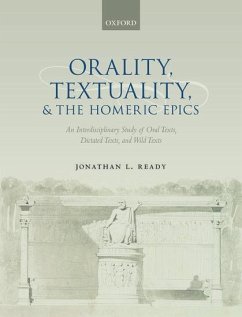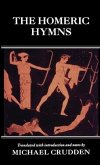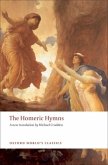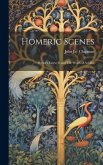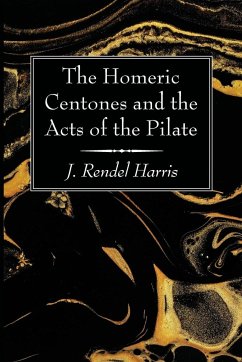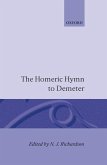Ready
Orality, Textuality, and the Homeric Epics
Ready
Orality, Textuality, and the Homeric Epics
- Gebundenes Buch
Andere Kunden interessierten sich auch für
![The Homeric Hymns The Homeric Hymns]() The Homeric Hymns169,99 €
The Homeric Hymns169,99 €![The Homeric Hymns The Homeric Hymns]() Thelma SargentThe Homeric Hymns14,99 €
Thelma SargentThe Homeric Hymns14,99 €![Homeric Hymns Homeric Hymns]() HomerHomeric Hymns8,99 €
HomerHomeric Hymns8,99 €![Homeric Scenes: Hector's Farewell, and The Wrath of Achilles Homeric Scenes: Hector's Farewell, and The Wrath of Achilles]() John Jay ChapmanHomeric Scenes: Hector's Farewell, and The Wrath of Achilles28,99 €
John Jay ChapmanHomeric Scenes: Hector's Farewell, and The Wrath of Achilles28,99 €![Homer and the Homeric Hymns Homer and the Homeric Hymns]() Helaine L. SmithHomer and the Homeric Hymns51,99 €
Helaine L. SmithHomer and the Homeric Hymns51,99 €![The Homeric Centones and the Acts of the Pilate The Homeric Centones and the Acts of the Pilate]() J. Rendel HarrisThe Homeric Centones and the Acts of the Pilate14,99 €
J. Rendel HarrisThe Homeric Centones and the Acts of the Pilate14,99 €![The Homeric Hymn to Demeter The Homeric Hymn to Demeter]() N. J. Richardson (ed.)The Homeric Hymn to Demeter202,99 €
N. J. Richardson (ed.)The Homeric Hymn to Demeter202,99 €-
-
-
Produktdetails
- Verlag: ACADEMIC
- Seitenzahl: 372
- Erscheinungstermin: 30. Juli 2019
- Englisch
- Abmessung: 260mm x 208mm x 25mm
- Gewicht: 1019g
- ISBN-13: 9780198835066
- ISBN-10: 019883506X
- Artikelnr.: 56399101
- Herstellerkennzeichnung
- Libri GmbH
- Europaallee 1
- 36244 Bad Hersfeld
- gpsr@libri.de
Jonathan L. Ready is a professor of classical studies at Indiana University. He is the author of Character, Narrator, and Simile in the Iliad (Cambridge University Press, 2011) and The Homeric Simile in Comparative Perspectives: Oral Traditions from Saudi Arabia to Indonesia (Oxford University Press, 2018), as well as numerous articles on Homeric poetry. He is also the co-editor of Homer in Performance: Rhapsodes, Narrators, and Characters (University of Texas Press, 2018) with Christos C. Tsagalis and serves as the co-editor of the annual Yearbook of Ancient Greek Epic (Brill).
* 0: Introduction
* Part I: Oral Texts and Oral Intertextuality
* 1: Oral Texts and Entextualization in the Homeric Epics
* Introduction
* 1.1: Performance, Oral Texts, and Entextualization
* 1.2: Application to the Homeric Epics
* 1.2.1: The Preexistence of Tales and Songs and the Object-Like Status
of Utterances in the Homeric Epics
* 1.2.2: Entextualization in the Character Text I
* 1.2.3: Entextualization in the Character Text II
* 1.2.4: The Poet and Entextualization
* 1.3: Homerists on Texts
* 2: Oral Intertextuality and Mediational Routines in the Homeric Epics
* Introduction
* 2.1: Oral Intertextuality and Mediational Routines
* 2.2: Mediational Routines in the Homeric Epics
* 2.2.1: The Source Text
* 2.2.2: The Target Text
* 2.3: Metapoetic Implications
* Part II: The Emergence of Written Texts
* 3: Textualization: Dictation and Written Versions of the Iliad and
the Odyssey
* Introduction
* 3.1: The Dictation Model
* 3.2: A Comparative Approach
* 3.3: The Process of Recording by Hand
* 3.3.1: The Challenges of Manual Transcription
* 3.3.2: Steps to Work around These Challenges and Their Effects
* 3.3.3: The Rare Exceptions
* 3.3.4: Dictated Texts versus Sung Texts
* 3.3.5: What Was Written Down
* 3.3.5.1: The Collector as Gatekeeper
* 3.3.5.2: The Scribal Process
* 3.4: The Collector's Impact on the Oral Text
* 3.4.1: Unwitting Interference (or the Collector's Presence)
* 3.4.2: Purposeful Interference
* 3.5: Editing
* 3.5.1: Field Notes
* 3.5.2: Editorial Work in the Nineteenth and Twentieth Centuries
* 3.5.3: Editorial Work from the Second Half of the Twentieth Century
until Today
* 3.6: Best Practices
* 3.7: The Collector's Text versus the Performer's Oral Performance
* 3.8: The Formulations in Section 3.1 Reevaluated
* 3.9: The Evolutionary Model's Transcript
* Excursus: The Interventionist Textmaker and Herodotus's Histories
* Part III: Copying Written Texts
* 4: The Scribe as Performer and the Ptolemaic Wild Papyri of the
Homeric Epics
* Introduction
* 4.1: The Ptolemaic Wild Papyri of the Homeric Epics
* 4.2: The Nature of the Variation: Not Scribal Error
* 4.3: Accounting for This Variation
* 4.4: The Scribe as Performer
* 4.5: The Scribe as Performer and the Wild Homeric Papyri
* 4.5.1: The Wild Papyri and the Comparanda
* 4.5.2: When?
* 4.5.3: Who?
* 5: Scribal Performance in the Ptolemaic Wild Papyri of the Homeric
Epics
* Introduction
* 5.1: Juxtaposing the Wild Papyri and Helmut van Thiel's Text
* 5.2: Competence and Entextualization
* 5.2.1: Cohesion
* 5.2.2: Coherence
* 5.3: Competence and Completeness
* 5.3.1: Characters Do More Things
* 5.3.2: Nothing Is Assumed
* 5.4: Competence and "Affecting Power"
* 5.4.1: The Emotions
* 5.4.2: The Fulfillment of Expectations and the Groove
* 5.5: Tradition, Traditionalization, and the Intertextual Gap
* 5.6: The Bookroll
* 5.7: The Performing Scribe
* 5.8: Scribal Performance and the Alternatives
* 6: Conclusion
* Endmatter
* Works Cited
* Index
* Part I: Oral Texts and Oral Intertextuality
* 1: Oral Texts and Entextualization in the Homeric Epics
* Introduction
* 1.1: Performance, Oral Texts, and Entextualization
* 1.2: Application to the Homeric Epics
* 1.2.1: The Preexistence of Tales and Songs and the Object-Like Status
of Utterances in the Homeric Epics
* 1.2.2: Entextualization in the Character Text I
* 1.2.3: Entextualization in the Character Text II
* 1.2.4: The Poet and Entextualization
* 1.3: Homerists on Texts
* 2: Oral Intertextuality and Mediational Routines in the Homeric Epics
* Introduction
* 2.1: Oral Intertextuality and Mediational Routines
* 2.2: Mediational Routines in the Homeric Epics
* 2.2.1: The Source Text
* 2.2.2: The Target Text
* 2.3: Metapoetic Implications
* Part II: The Emergence of Written Texts
* 3: Textualization: Dictation and Written Versions of the Iliad and
the Odyssey
* Introduction
* 3.1: The Dictation Model
* 3.2: A Comparative Approach
* 3.3: The Process of Recording by Hand
* 3.3.1: The Challenges of Manual Transcription
* 3.3.2: Steps to Work around These Challenges and Their Effects
* 3.3.3: The Rare Exceptions
* 3.3.4: Dictated Texts versus Sung Texts
* 3.3.5: What Was Written Down
* 3.3.5.1: The Collector as Gatekeeper
* 3.3.5.2: The Scribal Process
* 3.4: The Collector's Impact on the Oral Text
* 3.4.1: Unwitting Interference (or the Collector's Presence)
* 3.4.2: Purposeful Interference
* 3.5: Editing
* 3.5.1: Field Notes
* 3.5.2: Editorial Work in the Nineteenth and Twentieth Centuries
* 3.5.3: Editorial Work from the Second Half of the Twentieth Century
until Today
* 3.6: Best Practices
* 3.7: The Collector's Text versus the Performer's Oral Performance
* 3.8: The Formulations in Section 3.1 Reevaluated
* 3.9: The Evolutionary Model's Transcript
* Excursus: The Interventionist Textmaker and Herodotus's Histories
* Part III: Copying Written Texts
* 4: The Scribe as Performer and the Ptolemaic Wild Papyri of the
Homeric Epics
* Introduction
* 4.1: The Ptolemaic Wild Papyri of the Homeric Epics
* 4.2: The Nature of the Variation: Not Scribal Error
* 4.3: Accounting for This Variation
* 4.4: The Scribe as Performer
* 4.5: The Scribe as Performer and the Wild Homeric Papyri
* 4.5.1: The Wild Papyri and the Comparanda
* 4.5.2: When?
* 4.5.3: Who?
* 5: Scribal Performance in the Ptolemaic Wild Papyri of the Homeric
Epics
* Introduction
* 5.1: Juxtaposing the Wild Papyri and Helmut van Thiel's Text
* 5.2: Competence and Entextualization
* 5.2.1: Cohesion
* 5.2.2: Coherence
* 5.3: Competence and Completeness
* 5.3.1: Characters Do More Things
* 5.3.2: Nothing Is Assumed
* 5.4: Competence and "Affecting Power"
* 5.4.1: The Emotions
* 5.4.2: The Fulfillment of Expectations and the Groove
* 5.5: Tradition, Traditionalization, and the Intertextual Gap
* 5.6: The Bookroll
* 5.7: The Performing Scribe
* 5.8: Scribal Performance and the Alternatives
* 6: Conclusion
* Endmatter
* Works Cited
* Index
* 0: Introduction
* Part I: Oral Texts and Oral Intertextuality
* 1: Oral Texts and Entextualization in the Homeric Epics
* Introduction
* 1.1: Performance, Oral Texts, and Entextualization
* 1.2: Application to the Homeric Epics
* 1.2.1: The Preexistence of Tales and Songs and the Object-Like Status
of Utterances in the Homeric Epics
* 1.2.2: Entextualization in the Character Text I
* 1.2.3: Entextualization in the Character Text II
* 1.2.4: The Poet and Entextualization
* 1.3: Homerists on Texts
* 2: Oral Intertextuality and Mediational Routines in the Homeric Epics
* Introduction
* 2.1: Oral Intertextuality and Mediational Routines
* 2.2: Mediational Routines in the Homeric Epics
* 2.2.1: The Source Text
* 2.2.2: The Target Text
* 2.3: Metapoetic Implications
* Part II: The Emergence of Written Texts
* 3: Textualization: Dictation and Written Versions of the Iliad and
the Odyssey
* Introduction
* 3.1: The Dictation Model
* 3.2: A Comparative Approach
* 3.3: The Process of Recording by Hand
* 3.3.1: The Challenges of Manual Transcription
* 3.3.2: Steps to Work around These Challenges and Their Effects
* 3.3.3: The Rare Exceptions
* 3.3.4: Dictated Texts versus Sung Texts
* 3.3.5: What Was Written Down
* 3.3.5.1: The Collector as Gatekeeper
* 3.3.5.2: The Scribal Process
* 3.4: The Collector's Impact on the Oral Text
* 3.4.1: Unwitting Interference (or the Collector's Presence)
* 3.4.2: Purposeful Interference
* 3.5: Editing
* 3.5.1: Field Notes
* 3.5.2: Editorial Work in the Nineteenth and Twentieth Centuries
* 3.5.3: Editorial Work from the Second Half of the Twentieth Century
until Today
* 3.6: Best Practices
* 3.7: The Collector's Text versus the Performer's Oral Performance
* 3.8: The Formulations in Section 3.1 Reevaluated
* 3.9: The Evolutionary Model's Transcript
* Excursus: The Interventionist Textmaker and Herodotus's Histories
* Part III: Copying Written Texts
* 4: The Scribe as Performer and the Ptolemaic Wild Papyri of the
Homeric Epics
* Introduction
* 4.1: The Ptolemaic Wild Papyri of the Homeric Epics
* 4.2: The Nature of the Variation: Not Scribal Error
* 4.3: Accounting for This Variation
* 4.4: The Scribe as Performer
* 4.5: The Scribe as Performer and the Wild Homeric Papyri
* 4.5.1: The Wild Papyri and the Comparanda
* 4.5.2: When?
* 4.5.3: Who?
* 5: Scribal Performance in the Ptolemaic Wild Papyri of the Homeric
Epics
* Introduction
* 5.1: Juxtaposing the Wild Papyri and Helmut van Thiel's Text
* 5.2: Competence and Entextualization
* 5.2.1: Cohesion
* 5.2.2: Coherence
* 5.3: Competence and Completeness
* 5.3.1: Characters Do More Things
* 5.3.2: Nothing Is Assumed
* 5.4: Competence and "Affecting Power"
* 5.4.1: The Emotions
* 5.4.2: The Fulfillment of Expectations and the Groove
* 5.5: Tradition, Traditionalization, and the Intertextual Gap
* 5.6: The Bookroll
* 5.7: The Performing Scribe
* 5.8: Scribal Performance and the Alternatives
* 6: Conclusion
* Endmatter
* Works Cited
* Index
* Part I: Oral Texts and Oral Intertextuality
* 1: Oral Texts and Entextualization in the Homeric Epics
* Introduction
* 1.1: Performance, Oral Texts, and Entextualization
* 1.2: Application to the Homeric Epics
* 1.2.1: The Preexistence of Tales and Songs and the Object-Like Status
of Utterances in the Homeric Epics
* 1.2.2: Entextualization in the Character Text I
* 1.2.3: Entextualization in the Character Text II
* 1.2.4: The Poet and Entextualization
* 1.3: Homerists on Texts
* 2: Oral Intertextuality and Mediational Routines in the Homeric Epics
* Introduction
* 2.1: Oral Intertextuality and Mediational Routines
* 2.2: Mediational Routines in the Homeric Epics
* 2.2.1: The Source Text
* 2.2.2: The Target Text
* 2.3: Metapoetic Implications
* Part II: The Emergence of Written Texts
* 3: Textualization: Dictation and Written Versions of the Iliad and
the Odyssey
* Introduction
* 3.1: The Dictation Model
* 3.2: A Comparative Approach
* 3.3: The Process of Recording by Hand
* 3.3.1: The Challenges of Manual Transcription
* 3.3.2: Steps to Work around These Challenges and Their Effects
* 3.3.3: The Rare Exceptions
* 3.3.4: Dictated Texts versus Sung Texts
* 3.3.5: What Was Written Down
* 3.3.5.1: The Collector as Gatekeeper
* 3.3.5.2: The Scribal Process
* 3.4: The Collector's Impact on the Oral Text
* 3.4.1: Unwitting Interference (or the Collector's Presence)
* 3.4.2: Purposeful Interference
* 3.5: Editing
* 3.5.1: Field Notes
* 3.5.2: Editorial Work in the Nineteenth and Twentieth Centuries
* 3.5.3: Editorial Work from the Second Half of the Twentieth Century
until Today
* 3.6: Best Practices
* 3.7: The Collector's Text versus the Performer's Oral Performance
* 3.8: The Formulations in Section 3.1 Reevaluated
* 3.9: The Evolutionary Model's Transcript
* Excursus: The Interventionist Textmaker and Herodotus's Histories
* Part III: Copying Written Texts
* 4: The Scribe as Performer and the Ptolemaic Wild Papyri of the
Homeric Epics
* Introduction
* 4.1: The Ptolemaic Wild Papyri of the Homeric Epics
* 4.2: The Nature of the Variation: Not Scribal Error
* 4.3: Accounting for This Variation
* 4.4: The Scribe as Performer
* 4.5: The Scribe as Performer and the Wild Homeric Papyri
* 4.5.1: The Wild Papyri and the Comparanda
* 4.5.2: When?
* 4.5.3: Who?
* 5: Scribal Performance in the Ptolemaic Wild Papyri of the Homeric
Epics
* Introduction
* 5.1: Juxtaposing the Wild Papyri and Helmut van Thiel's Text
* 5.2: Competence and Entextualization
* 5.2.1: Cohesion
* 5.2.2: Coherence
* 5.3: Competence and Completeness
* 5.3.1: Characters Do More Things
* 5.3.2: Nothing Is Assumed
* 5.4: Competence and "Affecting Power"
* 5.4.1: The Emotions
* 5.4.2: The Fulfillment of Expectations and the Groove
* 5.5: Tradition, Traditionalization, and the Intertextual Gap
* 5.6: The Bookroll
* 5.7: The Performing Scribe
* 5.8: Scribal Performance and the Alternatives
* 6: Conclusion
* Endmatter
* Works Cited
* Index

